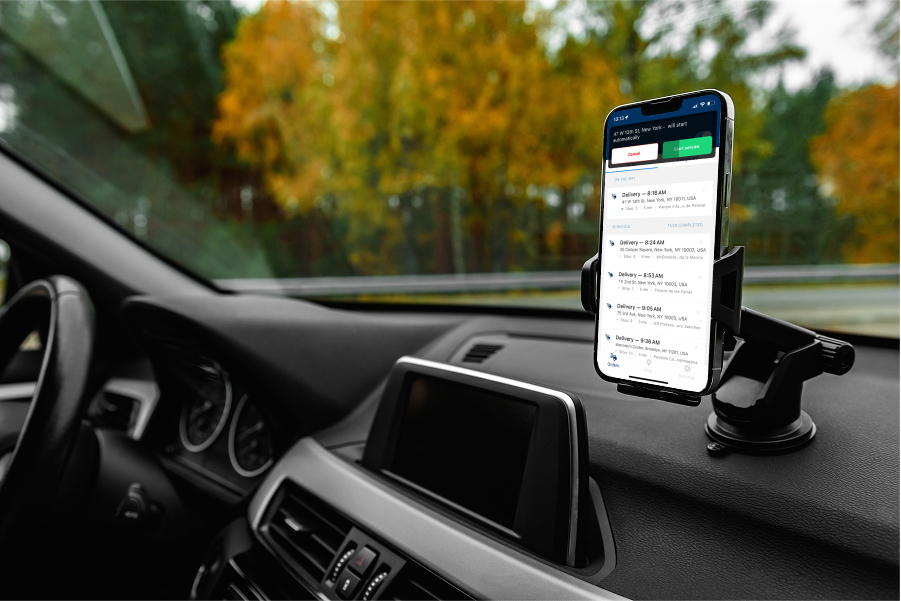What Is Geofencing? A Beginner’s Guide for Dispatchers in Logistics and Field Operations
Lectura de 4 min

Technology in logistics and field service can really make a difference in automating tasks and streamlining your operations. In this guide we’re going to cover how geofencing technology works and what the benefits are for companies working with a mobile workforce.
Here’s what you’ll find in the guide, use these links to jump ahead if you want:
What Is Geofencing?
Why Geofencing Matters in Logistics & Field Service
Geofencing in Practice
The Big Picture
Incorporating Geofencing into Operations
What Is Geofencing?
Geofencing is the use of virtual boundaries to determine where a service area begins and ends. Geofencing capabilities can be set up using software that uses GPS to draw an invisible boundary on a map and automatically takes action when a device enters or leaves that area, like starting or completing a service, sending a notification, or limiting actions based on the geofence.
Geofencing technology is used in logistics and field service to perform the following actions:
- Mark an order as “arrived” or “completed”. For example, a delivery driver enters the zone around a customer’s home, and the system marks the stop as started. When they leave, it auto-completes the order.
- Track time on site. Time spent within a geofence is used to calculate job duration which is great for billing, payroll, and compliance.
- Send alerts to managers or dispatch. If a technician finishes early or enters a restricted zone, dispatch can be alerted.
- Notify customers of ETAs automatically. A text or email is sent when a delivery is approaching, based on entering a geofenced area.
Why Geofencing Matters in Logistics & Field Service
Geofencing is a great tool for logistics and field service providers who are looking to automate certain parts of their routing and dispatching operations. Here are some benefits of incorporating geofencing:
- Saves time and money
Geofencing is, at its core, GPS-based service automation. It helps reduce time spent reporting on entering and exiting an area. By automating updates, you can find and fix delays faster. Logistics firms report up to 30% better delivery efficiency thanks to geofencing. - Mejor experiencia del cliente
Geofencing technology makes it possible to send real‑time alerts when a delivery is close. These accurate ETAs reduce missed appointments and boost customer trust. For example, a city waste management team used geofencing to reduce missed stops by 25% just by making sure route logs were tied to actual GPS triggers, not manual entry. - Improves safety & accountability
Geofencing automatically tracks technician arrival and departure. This provides a record for management that can be used for payroll accuracy and policy enforcement. - Stronger operational insight
Geofencing collects data that can be analyzed to improve operational performance and effectiveness. Analytics dashboards can be used to spot bottlenecks and improve routes.
Geofencing in Practice
Let’s say you manage a team of drivers delivering food to homes. Here’s how geofencing works in the real world:
- A geofence is set around each customer location using software with built-in geofencing technology.
- When the driver enters the geofence, the system marks the order as “Arrived” or triggers a notification.
- When the driver exits the geofence, the system can automatically mark the order as “Completed”.
And because this technology is integrated and automatic, this is all hands-free.

This same logic applies to:
- Field inspections: A technician arrives at a job site, and the system logs the visit without requiring check-in.
- Recolección de residuos: Trucks enter a neighborhood zone and automatically log time spent servicing each area.
- Pharmaceutical deliveries: Sensitive items that must arrive within time windows can be closely tracked through automated geofencing alerts.
The Big Picture
- The geofencing market is growing fast, around 30% annual growth, and was worth over $2 billion by 2022, with transportation & logistics leading the way.
- 50–60% of logistics and transportation companies have already adopted geofencing for fleet management, route optimization, and real-time tracking. That means more companies are adding geofencing to streamline their work and serve customers better.
Incorporating Geofencing into Operations
Geofencing is a capability offered by many software providers in routing and dispatching. You may already have access to this capability without knowing it. If you aren’t using any routing or dispatching software, take a look at what’s out there on the market.
Here is a quick overview about how to incorporate geofencing into your existing operations:
- Identify your needs. To start using geofencing, first identify what you want to improve, like arrival tracking, proof of service, or less manual input.
- Choose a tool. From there, you can choose software that offers custom geofence zones, mobile compatibility, automatic status updates, and integration with your routing tools.
- Make an implementation plan. Because this type of technology is automatic and doesn’t require much input, training is low and more informational than practical. Even so, roll it out gradually with one team or region, then expand once it’s working smoothly and to your liking. Sometimes geofencing requires tweaking to ensure the technology is serving your real-world needs.
- Analyze and improve. Finally, use the data you collect, such as time on site or missed stops, to optimize routes, staffing, and customer experience.
Geofencing is like giving every vehicle, technician, or truck a digital footprint. It makes sure everyone’s in the right place at the right time. You save time, cut costs, and make customers happier, all with invisible, simple-to-use tech.
Pruebe OptimoRoute™ gratis
No se requiere instalación ni tarjeta de crédito


